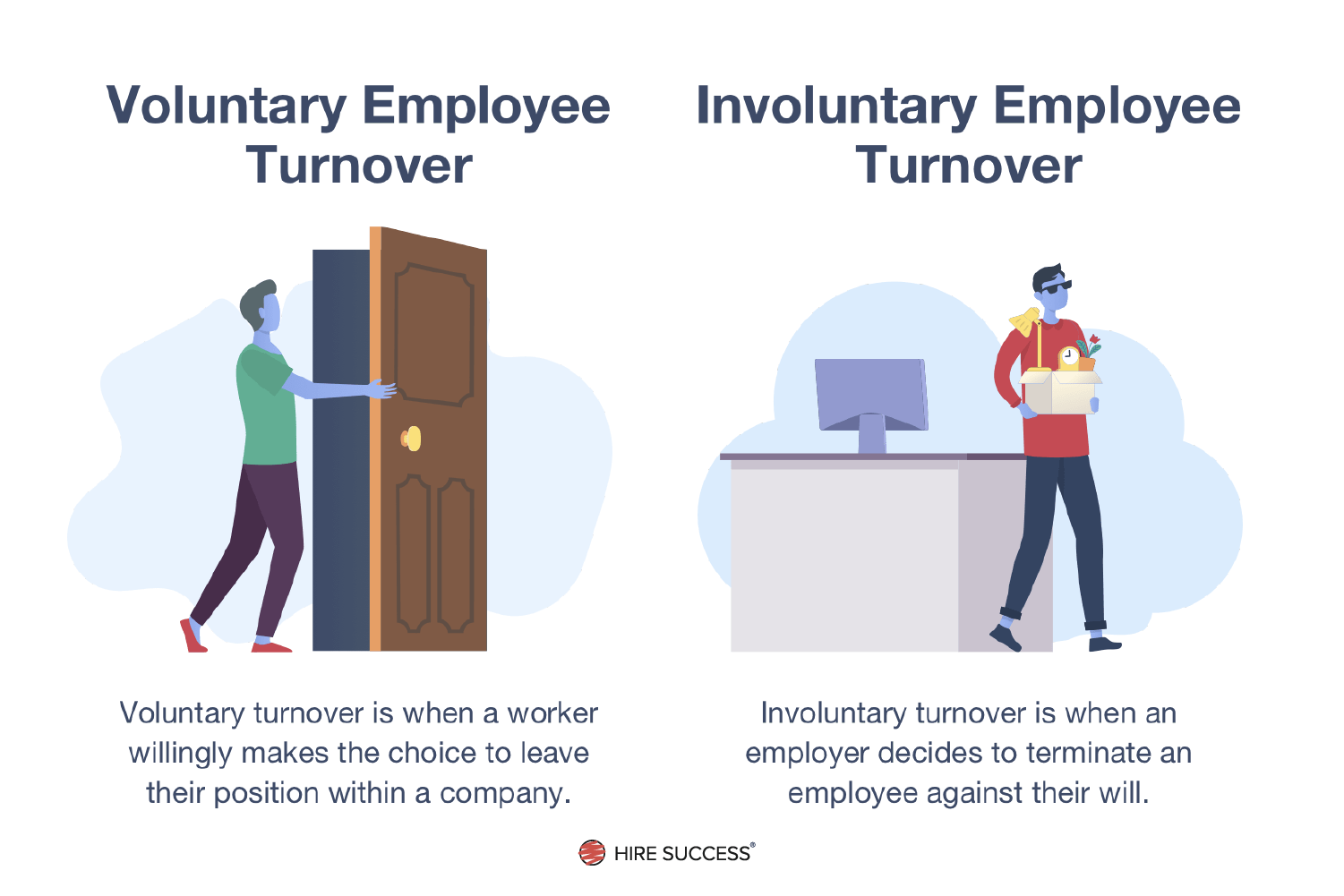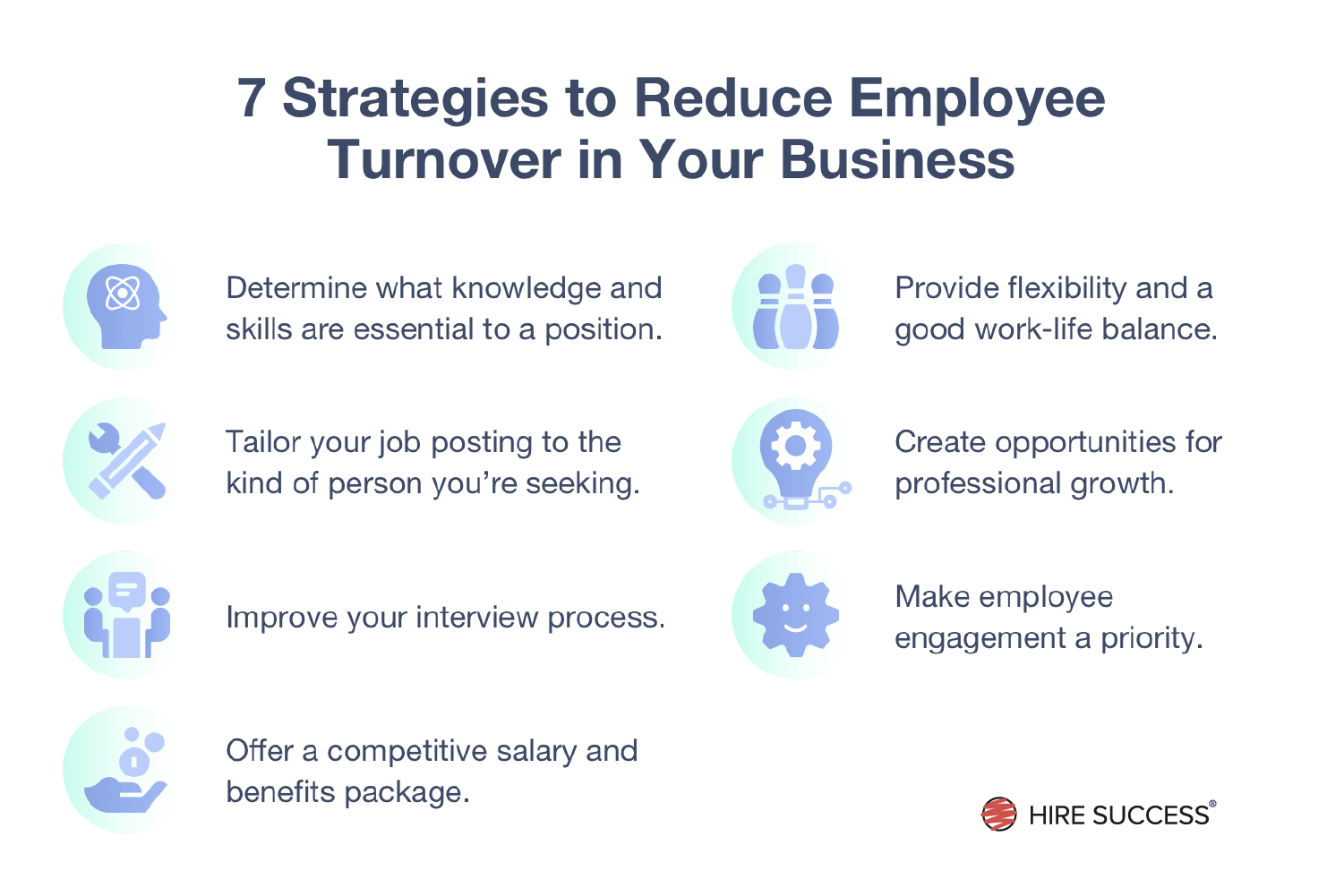Losing valuable employees is expensive, disruptive and time-consuming. Between severance pay, temp coverage, hiring expenses and training new employees, the costs of losing staff — especially top performers — can quickly add up. If you’re like many managers, you seek strategies to keep your people happy and reduce employee turnover.
That’s why having effective strategies to reduce employee turnover will pay for itself. Ultimately, effective retention begins with forward communication about needs and wants for both sides. Successfully doing so will be the difference between turnover and retention.
What is employee turnover and why does it matter?
When companies fill the roles of former staff with fresh hires, that's employee turnover. Most companies track the employee turnover rate periodically.
The COVID-19 pandemic had a surprising effect on employee turnover. Dubbed "The Great Resignation” or "The Great Walk Away” by economic analysts, millions of people left their jobs in search of new opportunities. Still, the unemployment rate remains steady at 4%. Some workers are finding better jobs and many are leaving to start their own businesses or work in the gig economy.
Employees leave for many reasons. Some losses are inevitable, but if your employee turnover rate is high, you have a costly inconvenience.
Types of employee turnover: voluntary vs. involuntary
Employee turnover is often voluntary and involuntary. When an employee decides to leave, it's voluntary turnover. If the employee is terminated, it is involuntary turnover. Because each type of turnover is different, tracking both voluntary and involuntary turnover can help pinpoint your problem.
- Voluntary turnover. Voluntary turnover is when a worker chooses to leave their job for any reason. This includes new job opportunities, adverse health, helping family, emigration, and entrepreneurship.
- Involuntary turnover. Involuntary turnover is often the result of termination. This includes firings, lay offs, and contractuals. Understanding why people must be fired is another important metric. If it happens often, the problem may be bad management, a toxic workplace, or practices resulting in bad hires.
While these are the most common types of employee turnover, there are other classifications. For example, an occasional employee may retire, die or vacate their position due to an internal transfer. Employee transfer doesn’t always reflect badly on the company or position. However, if turnover is consistently high, it’s imperative to know why.

7 common causes of employee turnover in an organization
There are many reasons an employee may leave or face termination. Some reasons for termination are obvious. Absenteeism or theft are great reasons to administer integrity tests before hiring. In many cases, the reason for leaving could likely be avoided with proper retention management strategies.
Common causes of employee turnover include the following:
- Improper management. When employee turnover rate is high, poor management is often the cause. Managers set the tone for the workplace. Bad managers may micromanage, and treat employees badly or unfairly. They may show favoritism. This creates a toxic work environment and often results in high turnover.
- Poor employee selection. In some cases, the employee is not a good fit for the job. They may not have the right skill set or temperament to meet requirements. Your hiring process needs an overhaul if that happens often.
- Overworking employees or setting unrealistic expectations. Chronically overworked employees are most likely unhappy and unhealthy. Your workers need and deserve a reasonable work-life balance. Without it, they will seek another job.
- Few opportunities for growth and advancement. It’s important to invest in your employees and offer room for professional growth. Failing to do so could drive top talent away. Many employees favor mobility over a dead-end job.
- Unsatisfactory wages or benefits. Employees will be incentivized to leave your company if you’re not offering a salary and benefits package in lockstep with industry standards. Research your competition and ask employees for input to ensure adequate offers.
- Inadequate training and learning resources. When new employees arrive, they need support to be successful. They may also need additional training throughout their career with your company as procedures change and new technology is introduced. Without training materials and learning resources, even an experienced employee can fall behind to change.
- Lack of feedback and acknowledgement. Without sufficient feedback and recognition, employees may experience reduced morale and start seeking new job opportunities. Acknowledgement makes workers feel valued.
7 strategies to reduce employee turnover for your business
Part of reducing turnover and improving employee retention is ensuring staff are happy, involved, and feeling fulfillment from their roles. Strategize hiring the right people for each role.
When you hire the right person for a role, you avoid making a costly mistake. Bad hires can interrupt workflow for your entire team, or worse, wreak havoc on your company culture. One bad hire can cost your company a small fortune.

1. Determine what knowledge and skills are essential to a position
Before recruiting for a given position, it helps to know what skills and experience you’re looking for in a candidate.That’s only the beginning. What qualities and traits will lead to success in the role? You can identify these core traits by administering personality tests to existing top employees in the position to establish a baseline for success.
Once you’ve found hard and soft skills needed for the position, it’ll be easier to identify the candidates most qualified for the job. This reduces the chances of making a bad hire and dealing with costly employee turnover down the road.
2. Tailor your job posting to the kind of person you’re seeking
Once you’ve collected data on a preferred candidate, incorporate that information into job postings. You should indicate skills and traits needed for an open slot in a manner alluring to the right candidate. For instance, if your tests reveal that you’re looking for a Type A personality, write your job post in a way that appeals to a detail-oriented, ambitious person. Personality tests give you insight into what you should say and avoid.
Include details about your company culture and how the job fits within the larger goals of your business. Your ideal hires’ goals, personality and aspirations align with the rest of your vision. Beyond the skill set, you want a person who will fit in without disrupting your team’s workflow.
3. Improve your interview process
It’s important to determine your interview strategy in advance. For example, will you be using structured or unstructured interviews to assess candidates? What interview questions will you ask?
If you’ve administered a personality test per applicant, the system will automatically formulate candidate-specific questions for you. Targeted, effective questions provide insight into who candidates truly are and whether they’d be a good fit for your company.
Invest in future performance, predict long-term fit
Use our personality assessment to identify candidates who will thrive in their role and in your evolving organization.
Book a Demo Try It Free
4. Offer a competitive salary and benefits package
Managing employee turnover and retention is often linked to adequate compensation. It’s not uncommon for employees to leave a position because of inadequate pay or benefits. This means you can reduce employee turnover with competitive salary and comprehensive benefits packages.
An attractive benefits package can include:
- Affordable health, dental and life insurance plans
- Paid time off policy
- Commuter assistance
- Performance bonuses
- Health and wellness programs
5. Provide flexibility and a good work-life balance
A 2021 Gallup poll asked workers about remote work. Overall, 54% of employees who work remotely at least part time said they would ideally like to split their time between working at home and in the office. About 37% said they would like to work from home full time. Only 9% wanted to return to the office full time.
As schooling changes create childcare challenges, the demand for flexibility at work has surged. Offering staff a flexible work schedule can reduce employee turnover by promoting a healthy work-life balance. Beyond retention, these policies can also help attract new talent to your company.
6. Create opportunities for professional growth
According to research from the Work Institute, the top cause of employee turnover for the last ten years has been insufficient career development. If you’re worried about keeping your best employees, providing opportunities for career progression is a high-impact retention strategy.
How important is career development? SHRM reports that after Indiana University Health increased its education allowance and offered more career options, they reduced their employee turnover rate to 13%. That’s compared to a national average of 20%. The average hospital saved $337,500.
To create opportunities for your staff, offer ongoing training sessions, career coaching services, and access to professional events. Pre-employment personality tests can also improve employee development and succession planning processes by helping you better understand each employee.
7. Make employee engagement a priority.
Disengagement drives away talent. Gallup found that 74% of disengaged workers are either actively looking for new employment or watching for openings. Your retention strategy should include engagement strategies. Workers want to feel proud of their job and intrinsic to the company’s success.
On a personal level, you can tailor the right strategy for each employee based on the results of your pre-employment personality tests. Knowing how someone likes to receive feedback or deal with confrontation can foster a stronger employer-employee relationship.
In the bigger picture, responsibility is an important component of modern corporate culture. With the help of employees, participate in local or global initiatives. Charity participation fosters strong work relationships and company pride. Your employee personality and trait test results can help you decide what’s most important to staff.
Which tools can you use to reduce employee turnover?
Employees are a company’s greatest asset, which is why it’s so important to have effective retention management strategies in place. The foundation for retention is laid before you even see a potential job candidate’s application, early during the hiring process.
With the right tools and system offered by Hire Success®, you can quickly identify and shortlist top talent, as well as use pre-employment tests to improve hiring and managing of your new employees. Hire Success®’ data-driven approach allows you to take the guesswork out of hiring and management. With strong hires sticking around, you’ll save both time and money.
Effective hiring practices are a solid foundation for any company culture with engaged, productive workers. In the process, keep remote workers engaged by seeking their opinions, including them on video meetings and reminding them of their value.


